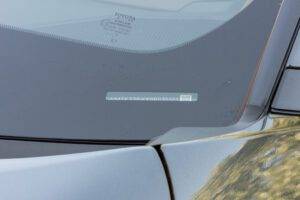How to Decode Your Ford’s VIN and Uncover Fascinating Insights

<?xml encoding=”utf-8″ ?????????>
A Vehicle Identification Number (VIN) is a unique code assigned to every motor vehicle produced and sold in the United States. The VIN serves as the vehicle’s fingerprint, distinguishing it from every other vehicle on the road.
VINs were introduced in the 1950s to track vehicles for safety and theft prevention. Over the years, the VIN system has evolved into a standardized 17-character format that reveals crucial details about a vehicle’s manufacturer, attributes, and history.
Here is an overview of the modern 17-digit VIN format:
Positions 1-3: World Manufacturer Identifier (WMI) – identifies the vehicle’s country of origin, manufacturer, and division
Positions 4-8: Vehicle Descriptor Section (VDS) – specifies vehicle attributes like model, body style, engine type, etc.
Positions 9-17: Vehicle Identifier Section (VIS) – sequentially generated production number
Understanding how to decode a VIN is important for identifying what you buy or sell. The WMI and VDS portions especially reveal crucial information about the vehicle that can’t be discerned just by looking under the hood.
VINs have become indispensable tools for regulators, manufacturers, dealers, and consumers to learn about a vehicle’s roots and track its history. The VIN tells a vehicle’s unique story and unlocks the power to make informed choices in the auto marketplace.
Decoding Ford VINs
Like other automakers, Ford uses a standard VIN format that contains key information about the vehicle. The VIN is 17 characters long and divided into three sections:
WMI (World Manufacturer Identifier) – The first three digits identify the manufacturer, make, and country of origin. For Ford vehicles, the first digit is 1, 2, 3, 4, or 5, indicating it was made in North America. The second digit specifies the manufacturer, with F representing Ford. The third digit denotes the vehicle type, such as car, truck, MPV, bus, etc.
VDS (Vehicle Descriptor Section)—The next six digits provide details about the vehicle attributes, such as model, body style, engine type, etc. This section varies the most between makes and models. Ford’s fourth digit often indicates the model line (F-series, E-series, etc.), while the fifth and sixth digits specify the engine and trim level.
VIS (Vehicle Identifier Section) – The last eight digits are the sequential serial number assigned to each vehicle. This number increments by one each time a new VIN is generated at the plant. The VIS identifies the individual vehicle.
The position of each character in the VIN indicates its meaning. Ford also uses both numbers and letters in its VINs to encode this data. For example, the fourth digit might be F for F-150, E for E-350 van, or M for Mustang. The fifth digit could be a letter specifying the engine. You can learn the vehicle’s attributes and history from the number sequence by decoding the VIN.
For instance, when eyeing a Ford on IAAI, it’s not just about looks; it’s about what lies beneath the surface. Taking a closer look at the VIN and cross-referencing it with trusted sources is like putting the vehicle under a microscope. It’s your chance to spot any hidden issues or discrepancies that could impact its value or safety. By doing your homework and inspecting the VIN, you’re not just buying a car but investing in confidence and security for the road ahead.
Ford Model Lineup Based on VIN
The Ford model can be identified by looking at the fifth character in the VIN, which is known as the “vehicle descriptor” section.
Here are the key Ford models and their 5th VIN character:
Fiesta: P
Focus: F
Fusion: U
Escape: U
Explorer: U
Expedition: U
Econoline: E
Ranger: R
F-150: F
Super Duty: F
As you can see, some models like the Escape, Explorer, Expedition, and Econoline all share the same 5th character, “U.” To distinguish between these models, you need to look at the 4th character, which indicates the vehicle category:
Escape: Small Sport Utility Vehicle
Explorer: Midsize Sport Utility Vehicle
Expedition: Full-size Sport Utility Vehicle
Econoline: Van
The F-150 and Super Duty trucks also share an “F” for the 5th character. Again, the 4th character indicates their sub-category:
F-150: Conventional Cab Pickup
Super Duty: Crew Cab Pickup
In summary, the full VIN contains detailed codes that allow you to pinpoint the exact Ford model. Focusing on the fourth and fifth characters together reveals the specific vehicle type, even when the broader model family is the same. This is very useful for identifying parts compatibility, trim levels, engine options, and other variations within the Ford lineup. In addition, leveraging Ford VIN decoding services provides a comprehensive and reliable method for accessing detailed information about your vehicle, ensuring accurate identification and confidently facilitating maintenance, repairs, and customization.
Ford Manufacturing Plants
Ford operates over 35 manufacturing plants worldwide, producing Ford and Lincoln vehicles, engines, transmissions, and other components. The locations of Ford’s major production facilities provide insights into the company’s global operations and logistics.
Ford’s largest plants in the United States are located in Michigan, including facilities in Dearborn, Flat Rock, Livonia, Romeo, and Wayne. Other major US plants are in Chicago, Illinois; Claycomo, Missouri; Avon Lake, Ohio; and Louisville, Kentucky. These plants produce some of Ford’s most popular models, such as the F-150, Mustang, Explorer, and Escape.
Ford has significant plants internationally in Canada, Mexico, Brazil, Argentina, Venezuela, Spain, Germany, Turkey, Russia, China, India, Thailand, Vietnam, and South Africa. This diverse footprint allows Ford to serve markets worldwide.
The VINs on Ford vehicles provide clues as to where they were manufactured. Each Ford plant is assigned a unique code that makes up the first character in the VIN. For example, “1” indicates vehicles made in the US, while “3” is for Mexican plants and “S” is for Germany. By decoding the origin plant, owners can learn exactly where their Ford was built.
Some of Ford’s principal US plant codes include:
F – Dearborn, MI
P – Flat Rock, MI
K – Avon Lake, OH
U – Louisville, KY
So a Ford with a VIN starting with “F” came from Ford’s legendary Rouge plant complex in Dearborn, while a “K” VIN indicates assembly in Ohio. This system provides an exciting glimpse into Ford’s far-reaching production capacity.
Model Year and Other Attributes
The model year of a Ford vehicle is essential information encoded in the VIN. For most Ford vehicles, the 10th digit of the VIN represents the model year. This digit corresponds to a year in the 1980s or later, with “A” representing 1980, “B” 1981, and so on up to the present year.
Knowing the model year tells you the design generation of that Ford vehicle. While models may have incremental changes year-to-year, more significant redesigns and new generations typically launch every 4-6 years. The model year digit also indicates safety and technology features that may have been introduced or changed for that year.
Other digits in the VIN also carry meaning. The 4th to 8th digits identify vehicle attributes like body style, engine type, trim level, and more. For example, a “P” in the 4th digit means it’s a passenger car rather than a truck. The engine type code in the 8th digit indicates details like the displacement, fuel type, and cylinder configuration.
Decoding the full VIN reveals insights into the vehicle’s design, technology features, performance attributes, and more based on when and where it was produced. This can be useful for valuation and understanding the parts, features, and service needs that are likely to apply. The VIN serves as a vehicle’s fingerprint, unlocking many details for those interpreting the code.




